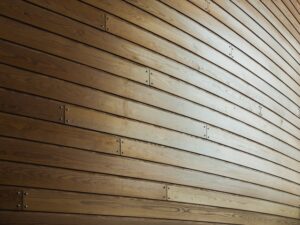How Long Can I Wait Before I Apply a Finish to New Exterior Wood?

Preweathering of Wood
A great deal of wood is used in exterior applications with direct contact to the elements. This includes decks, fences, siding, arbors, benches, pergolas, and more. Sometimes when construction is over it takes a while for the paint/finishing crew to show up or if it is a DIY project it may take some time before you can fit the painting/finishing into your busy schedule.
Long-term research at the USDA Forest Service Forest Products Laboratory (FPL) in Madison, WI has examined the effect of lag time between construction and final coating of exterior wood. This lag time is known as preweathering because the wood is weathered before the finish is applied. Whether the wood is to be painted, stained, or finished in any manner, preweathering for as little as 4 weeks is detrimental to the service life of any finish.
Recommendations
The FPL recommends that any unprotected wood not be allowed to weather for more than a maximum of two weeks before it is protected with some finish that will prevent photodegradation and water damage. This recommendation is based on years of research including a study that showed almost no wood/paint interface failure for Western red cedar samples that were weathered two weeks or less.
If working with pressure-treated lumber, the same advice applies. Be sure that the wood is clean and dry on the surface before finishing. Wet wood should be dry enough on the surface to finish within one to weeks if it stays dry. A minimum finish would be a water repellent preservative applied by brush or spray.
Theory
Most people know that wood is comprised of cellulose, hemicellulose, and lignin. There is one more minor component that is generally classified as “extractives.” These are largely phenolic-based compounds that can be extracted from the wood using various means. Some extractives can be removed by water. An unprotected stick of exterior wood will soon begin to develop an extractive gradient as the water-soluble compounds begin to move by a diffusion gradient to the surface. This gradient is similar to what develops in service with creosote-treated utility poles. This also occurs with interior wood but much slower. As the extractives move to the surface, the surface becomes darker in color and also is less “active.” A clean wood-finish bond cannot be achieved, and early finish failure is likely. This is particularly true for woods that are known to be high in extractives such as oak and hickory.
Meet the Author
Dr. Todd Shupe is the President of Wood Science Consulting, LLC. He is a well-recognized expert on wood forensics, wood preservation, wood decay and degradation, and wood species identification. He has a broad background in new product development, quality management, and marketing and sales in both the public and private sectors. For more information please visit DrToddShupe.com.
We welcome your comments below.
Thank you for visiting. We trust that you have enjoyed reading our articles.
Liked this post? Read more below or search for more topics . . .

